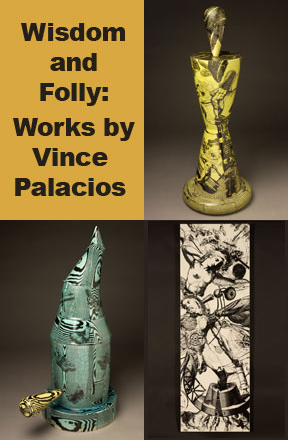November 5 – December 8, 2007
- Reception: Thursday, November 15 from 6-8 p.m., Gallery Lounge
- Music by Jordan Kaye
- Gallery Talk: Vince Palacios at 7 p.m.
 Wisdom and Folly Works by Vince Palacios features the solo exhibition of ceramic work by this respected artist. Vince Palacios, an assistant professor at Western Illinois University, received his B.F.A. from California State University Long Beach and his M.F.A. from Alfred University, Alfred, NY. His work reflects a complex dialogue between memory, improvisation, and humor. He confides, “I have always used humor in other areas of my life to disarm potential danger. It makes sense that humor should function to disarm in my artwork.”
Wisdom and Folly Works by Vince Palacios features the solo exhibition of ceramic work by this respected artist. Vince Palacios, an assistant professor at Western Illinois University, received his B.F.A. from California State University Long Beach and his M.F.A. from Alfred University, Alfred, NY. His work reflects a complex dialogue between memory, improvisation, and humor. He confides, “I have always used humor in other areas of my life to disarm potential danger. It makes sense that humor should function to disarm in my artwork.”
Lisa Costello, Director of Parkland College, asked Palacios about his inspirations and sources. In talking about the forms he explained, “I look a lot at scientific or lab forms. Especially glass beakers, condensers, etc. I am also interested in alchemy forms, which were early scientific forms, used for medicine. My primary concern is to have a surface big enough to work on, to create an image narrative. Because of that I am interested in primary or geometric forms like cones, cylinders and spheres. I am still trying to understand the relationship between the forms and the images.”
Palacios constructs complicated imagery on the forms, using decals and glaze to get the desired effects. “I find my images mostly in old dictionaries, medical journals and encyclopedias. I have used some clip art images but find them usually too common. I tend to look for the unusual. It is hard to second guess why I use some images.” He says “I just look for hours through books and images and when something strikes me I copy it as a potential image for decals. The decal images are just the starting point or the building blocks for the larger images that show up in the work. I build in a very free associative of improvisational way using decal images to build more complex images. I am deconstructing and reconstructing the images to give them new meaning.”
Decals are printed on a plastic film that slides off when soaked in water. They can be applied anywhere. Palacios first fires the glazed forms before applying the decals. He keeps the glaze simple so that they do not distract from the narrative of the decals. “Because it is a transparent film that the decal is printed on, you can overlap and build what seem to be seamless images composed of several different images. After applying the images the decals must dry and then they can be fired to about 1313 Fahrenheit.” He admits, “The frustrating thing for me working with decals is that it appears to most that I have large images made that are just stuck onto the form. In fact, my images are composed of thousands of smaller images collaged into complex narratives. It can take days to complete just one piece. I build up layer after layer of images until I arrive at an image that works for me.”